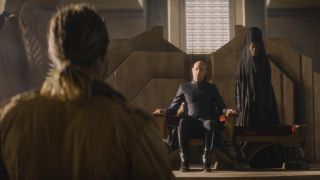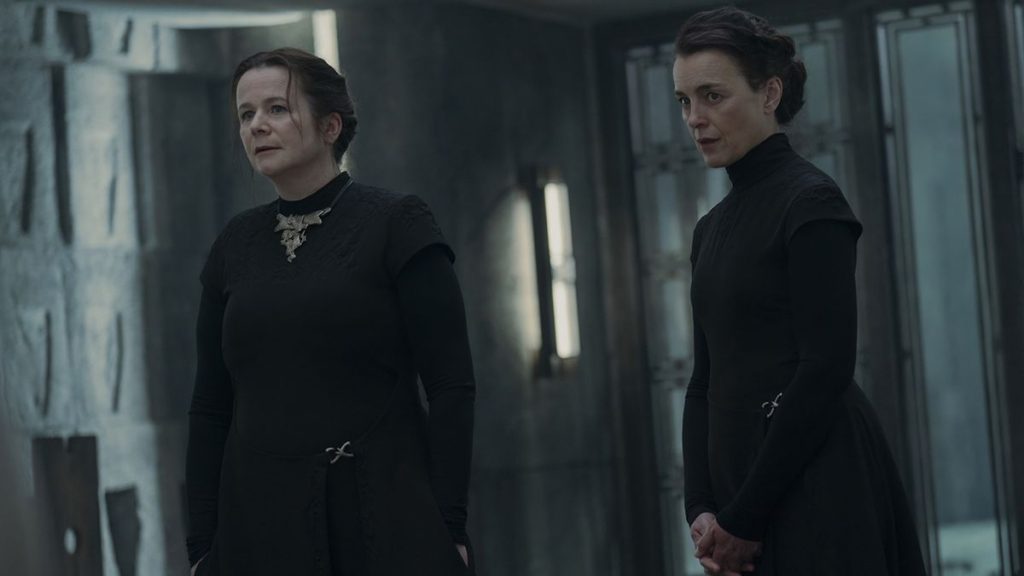With Dune: Part Two poised to land at least a handful of nominations at the Oscars 2025 after convincing most critics and moviegoers earlier this year, HBO’s prequel TV series Dune: Prophecy should be huge. So far, we think it’s off to a solid start, but what lies on the horizon?
Episodes 1 and 2 aren’t exactly a slam dunk of sci-fi goodness, but they’re a convincing enough first act that suggests Dune: Prophecy might have survived its many creative shakeups on the way to the small screen. The central pitch behind the show seems to be ‘let’s make Game of Thrones but with Frank Herbert’s universe’ — a logical fit for anyone who’s read some of the material it’s based on. Villeneuve’s Dune movies already went deep into political power plays and high-stakes drama, so the injection of such DNA doesn’t feel entirely new here. That said, the TV medium allows for more subplots to flourish and more ‘slow burns’ stories.

After watching the first two episodes (out of six), you’ll probably have many questions; what’s the ‘burning truth’ that Mother Superior Raquella Berto-Anirul talks about before passing away? And who or what is the Tiran-Arafel, the seemingly impending doom coming for both the Bene Gesserit and mankind as a whole?
Herbert’s Dune universe is currently the most active it’s ever been, with a third movie, based on Dune: Messiah, in the works and development on the ambitious MMO video game Dune: Awakening nearing the finish line. The spice will continue to flow.
Spoilers ahead for Dune: Prophecy episodes 1 & 2: ‘The Hidden Hand’ & ‘Two Wolves’
What is Tiran-Arafel?
Tiran-Arafel is, broadly, a prophecy of doom. Arafel is Hebrew and directly tied to the ideas of god and judgment, while Tiran means tyrant. With the words combined, the Sisterhood is directly addressing this looming threat as that of a tyrant versus a more ethereal menace. Within the context of the show, Tiran-Arafel are the final words of Mother Superior Raquella Berto-Anirul, setting up the peril that our protagonists face in this series.
Regardless of the brand-driven title change to make the whole show land ‘closer’ to Villeneuve’s big Dune movies, Dune: Prophecy is very much about The Sisterhood (Bene Gesserit) still and puts sisters Valya and Tula Harkonnen at the center of the picture.
If you’ve read and/or watched the two-part Dune adaptation, you’ll recognize the same central themes here. Even 10,000 years before Paul Atreides’ birth and rise to power as the Kwisatz Haderach, the Bene Gesserit are guiding the Imperium from the shadows, or at least trying to, as infighting threatens to undo their work before it’s properly begun. Of course, we know that Mother Superior Raquella’s genetics program prevails, as that’s directly addressed in Dune’s early story beats and one mistake leads to Paul Atreides threatening the political order and very idea of control that had been established for centuries.
How does Tiran-Arafel connect to the Sisterhood?
Why was The Sisterhood created, and what’s the organization’s endgame? Essentially, after the Butlerian Jihad (Machine War in the show), humanity needed to rebuild, and that included power structures.
The Bene Gesserit aimed to ‘guide’ mankind to try to avoid past mistakes born out of unchecked free will. Of course, this is just another form of control that could lead to disaster, even if the intentions are good, as they’re making huge decisions on their own for all the known universe.
Raquella’s prophecy, at least by the end of episode 2, is still being figured out by those who were close to her when she died. She spoke of a ‘burning truth’ and a tyrant that would threaten their existence, but didn’t mention whether it was an imminent threat or the long-term consequences of their actions.
Many centuries later, an entirely different prophecy is planted on Arrakis; one that speaks of a son of a Bene Gesserit that will lead the Fremen to freedom. While The Sisterhood focuses on the more immediate menace represented by Desmond Hart, what if this entire prophecy and their undoing arrive later, and what if it is unwittingly produced by them?
What if The Sisterhood is wrong about the prophecy?
By the time the main plot of Dune: Prophecy truly kicks off, many sisters have started to consider that the prophecy could’ve been misinterpreted (Star Wars prequels, anyone?), and Tula, while quiet and prudent, is the one person who could truly face Valya should the need arise. Is their own sisterhood already doomed to be broken? It seems like the more dramatic option on the table, but ‘The Hidden Hand’ and ‘Two Wolves’ smartly throw viewers a couple of curveballs, so bets are off right now.
After Pruitt Richese — the 9-year-old noble son to Duke Ferdinand Richese, a powerful man with a fighter fleet that the Emperor needs to protect Arrakis — and Reverend Mother Kasha Jinjo — personal advisor to Javicco — die under strange circumstances (literally burned to death), the ‘burning truth’ that Raquella teased comes to the forefront and into focus. But what if, in all their wisdom and commitment to planning ahead, the Bene Gesserit are missing the forest for the trees?
We know The Sisterhood is behind the attack on the spice mining operations on Arrakis; a simple maneuver to push Emperor Javicco to look for support through the marriage of Princess Ynez, a future Bene Gesserit, to the Richese heir. Thus both deaths right after the union at the royal palace are direct, precise hits against them. With Raquella’s words still echoing across the halls of The Sisterhood’s headquarters, it’s easy to see why they think the ‘burning truth’ is right in front of them.
Desmond Hart might also be trying to fulfill a prophecy of his own after seemingly dying on Arrakis (swallowed by a Shai-Hulud aka sandworm), but then returning not only unscathed, but also with lethal mind powers and one clear goal: cleansing the Imperium of The Sisterhood’s influence. If we had to bet right now, his survival and ‘holy’ mission is entirely unrelated to Raquella’s words about Tiran-Arafel, and even if he’s an enemy that Valya and her sisters need to deal with, chances are that Raquella’s warning was all about their own actions and the pain and chaos they’d cause down the line.
There’s a big on-screen threat, but who really is Tiran-Arafel?
The ‘burning truth’ seems inherently tied to the concept of Tiran-Arafel, an apocalypse for humankind that could be either a person or a thing. With the Machine War still in everyone’s minds (and Pruitt Richese’s little toy robot is a good reminder), the witches of Wallach IX are trying to correct the course they’d set as soon as possible.
Sure, all fingers point to Desmond at the moment, but we’re only one-third of the show through, and we all know what will happen with Paul Atreides millennia into the future due to The Sisterhood’s meddling. As Tula scrambles to obtain answers through Mother Superior Raquella’s descendant and a potentially lethal procedure, Valya questions the man who admits to Pruitt and Kasha’s assassinations.
Tula’s plan doesn’t pay off, with the young sister getting ‘lost’ in her own genetic memory and finding a troubling hidden truth about her very nature; yet another sign suggesting The Sisterhood is working on its own doom and should fear what they’re doing more than any external threat. Meanwhile, Valya, in her relentless pursuit of control at all costs, instantly brands Hart as the tyrant they were warned about. But what if he’s just a man who’s tapped into hidden power and just wants to sit by the Emperor’s side, to replace the Bene Gesserit for his own gain?
With Hart poised to be the series’ main ‘villain’ (if we could say there are good people in this story), the question of who the Tiran-Arafel is remains unclear on purpose. Sure, both his presence and actions fit in well with Raquella’s warnings, but at the end of the day, even The Sisterhood is at odds with its own teachings and goals. In the vast Dune universe, many things aren’t what they seem at first, and we can definitely think of one future judgment far scarier than whatever Desmond Hart ends up doing at this point in the timeline.

